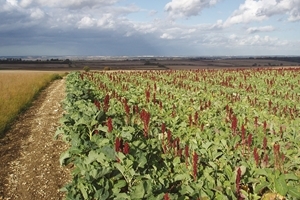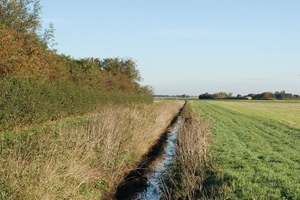Many farms have enough hares and will not want to encourage them further. These are often farms on light arable land and many have gamekeepers who keep fox numbers in check. On these areas there is no need to take special measures to conserve hare stocks.
Where hares are scarce, the Entry Level Stewardship (ELS) scheme can be used to improve their chances.
Arable farms
 Any scarcity of hares on arable farms is usually caused by a lack of summer grazing exacerbated by fox predation. In summer, mature crops force hares and leverets out to the field boundaries and track sides where they forage for herbs and grasses, but where they are easy for a patrolling fox to find and pick off.
Any scarcity of hares on arable farms is usually caused by a lack of summer grazing exacerbated by fox predation. In summer, mature crops force hares and leverets out to the field boundaries and track sides where they forage for herbs and grasses, but where they are easy for a patrolling fox to find and pick off.
On these farms, ELS options should aim to improve summer grazing across the farm. Special sowings of bird seed mixes (EF2) suit this purpose well. Spring sown, they will be short in early summer and contain a variety of annual weeds. Good mixtures are kale, triticale and quinoa, or linseed, triticale and millet. On light land uncropped, cultivated field margins (EF11) are a good option, as are cereal headlands without fertiliser (EF9 and EF10). Grass buffer strips (EE1-3) are popular with farmers, but the best of these is the six metre strip (EF3) where three metres are cut annually. Winter in-field grass areas (EJ5) are excellent for hares as are pollen and nectar mixes (EF4), but avoid cutting when leverets are about.
Stubbles, especially if they have a good green cover, are used extensively by brown hares. Two excellent options to ensure green cover within the ELS are reduced herbicide cereal crops followed by over-wintered stubble (EF15) and extended over-winter stubble (EF22). Although the option, uncropped cultivated areas for ground-nesting birds on arable land (EF13) was not designed for hares, the fact that they are positioned in the middle of fields and become weedy, means that hares will frequently use them.
Livestock farms
 Hares are often very scarce or absent on livestock farms, but this is not usually due to lack of food. Mostly it is caused by high mortality. Frequent grass cutting and exposure to predators like foxes and buzzards can mean that very few leverets survive their first few weeks. The main aim, therefore, is to provide cover where hares can hide. The best ELS option for this is field corners (EK1). These areas are ungrazed, unfertilised and only cut every five years. They make ideal patches of cover for hares and perfect places for leverets to hide. Make the patches as big as possible under the rules. Using these patches adjacent to low and very low input grass (options EK2 and EK3) is a good idea. Buffer strips of unmown and unfertilised grass (EE4-6) is a good cover option for hares on intensively managed grass.
Hares are often very scarce or absent on livestock farms, but this is not usually due to lack of food. Mostly it is caused by high mortality. Frequent grass cutting and exposure to predators like foxes and buzzards can mean that very few leverets survive their first few weeks. The main aim, therefore, is to provide cover where hares can hide. The best ELS option for this is field corners (EK1). These areas are ungrazed, unfertilised and only cut every five years. They make ideal patches of cover for hares and perfect places for leverets to hide. Make the patches as big as possible under the rules. Using these patches adjacent to low and very low input grass (options EK2 and EK3) is a good idea. Buffer strips of unmown and unfertilised grass (EE4-6) is a good cover option for hares on intensively managed grass.
Mixed farms
Some ELS options are designed to encourage mixed farming and will suit hares. Mixed farms in general are good for hares. Undersown spring cereal (EG1) re-creates part of the ley rotation and is perfect for hares.
Stewardship in Scotland and Wales
Many of the above options are available. However, there are key differences, so contact the relevant adminstrators for further information.